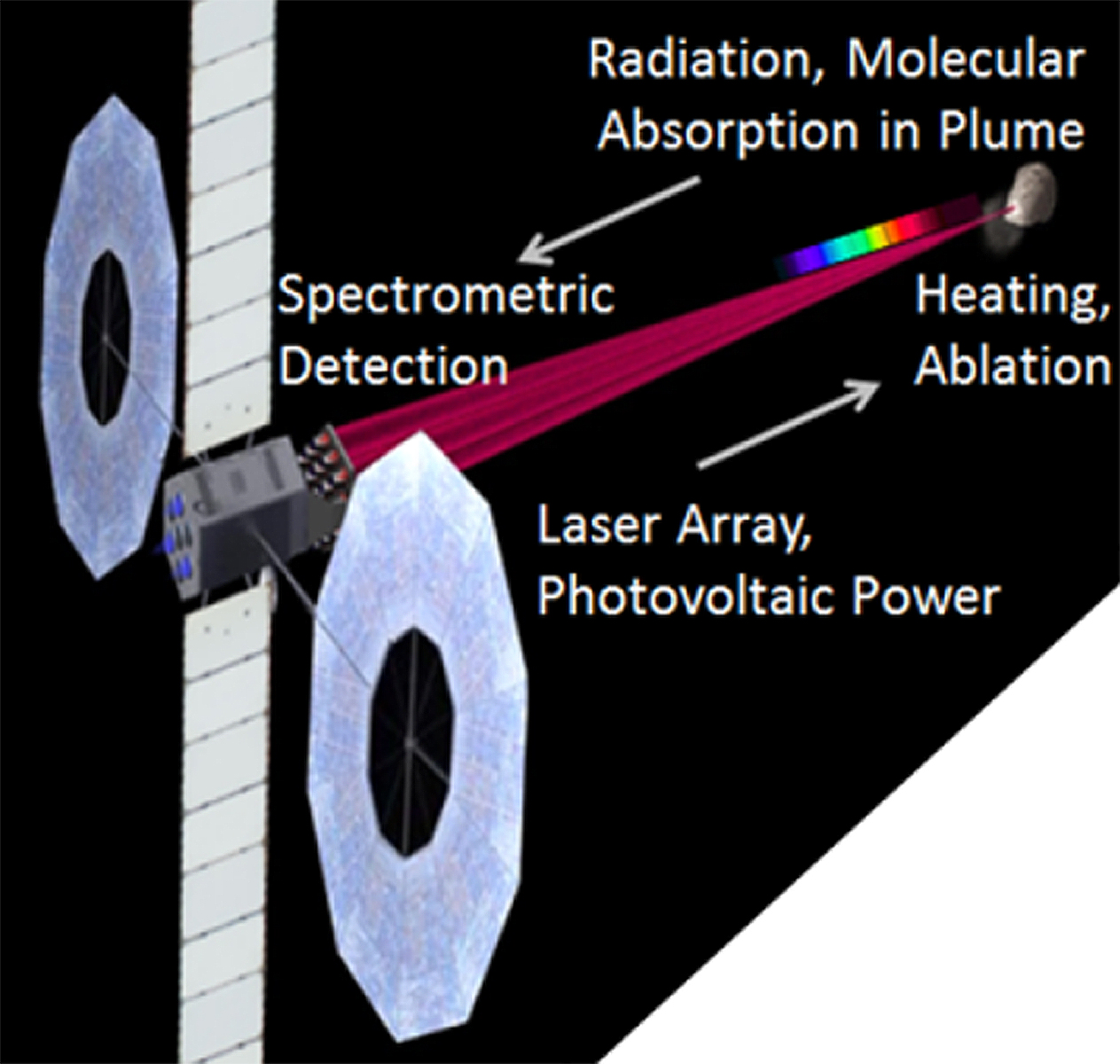Gary Hughes
California Polytechnic State University
Description
We propose a sensor system capable of remotely probing the molecular composition of cold solar system targets (asteroids, comets, planets, moons), such as from a spacecraft orbiting the target. The spacecraft would be equipped with a high-power laser and an infrared spectrometer, both powered by photovoltaics. The laser is directed at a spot on the target, with central flux in the 10 MW/ m2 range. For rocky targets, melting and evaporation of surface and shallow sub-surface material occurs. Due to phase changes, the spot temperature rapidly equilibrates at ~2500 K, but the flux is insufficient to dissociate most molecular species present. Blackbody radiation produced by the heated spot peaks near 1 μm, and travels outward through the evaporated plume. Fortuitously, the equilibration temperature of the heated spot emits peak radiation right in the spectral range where absorption occurs due to molecular rotational and vibrational modes. The heated spot is viewed by the spectrometer through the plume, and absorption lines can be exploited to infer the molecular composition of the target. The remote sensing system uses an artificial backlighted source, and relies on absorption of radiometric energy to determine molecular composition of the target, suggesting the designation Remote Laser Evaporative Molecular Absorption (R-LEMA) Spectroscopy Sensor System. The system is complementary to existing methods such as Laser-Induced Breakdown Spectroscopy (LIBS). The LIBS laser produces sufficient flux to vaporize and ionize the target material; the LIBS optical spectrometer observes characteristic emission from materials in the plasma, allowing determination of the atomic composition of the target.
Our Phase I efforts produced an end-to-end model of the sensor system, and simulated operational scenarios were explored. The model includes laser propagation and absorption by a simulated target. Absorption of laser energy drives heating, melting and evaporation of the target material. Evaporation in space environment conditions is predicted, leading to estimates of plume density in front of the heated spot. Finally, plume characteristics are used to calculate the expected absorption spectrum at the spectrometer. Additionally, preliminary experiments were performed to test some aspects of the model, including plume density and absorption.
All results obtained during Phase I indicate that the proposed sensor system concept is viable. We estimate the sensor system concept to be TRL-2 at the culmination of Phase I. The Phase II effort would potentially push the system concept from TRL-2 to TRL-4, by building a proof-of-concept laboratory model and running extensive experiments to test the theory developed in Phase I. In particular, Phase I results suggest the heated spot will produce sufficient blackbody flux to be viewed from a distance, i.e., flux is not the limiting component of the system. Phase I results also suggest that much of the absorption occurs within about one spot radius from the target. Thus, spectral detection is limited primarily by ejecta concentration, which is in turn controlled by the spot area where sufficient flux is delivered to produce evaporation. Any operational system should therefore seek to maximize evaporative spot area with available laser power.
For the Phase II effort, we propose to execute advanced laboratory experiments to measure parameters of interest, and to compare experimental results to analytical predictions that were developed in Phase I. The Phase II effort would potentially push the system concept from TRL-2 to TRL-4. During the Phase II grant period, we would also develop a roadmap to TRL-5, by specifying a cubesat experiment that could be executed in low-Earth orbit, over a modest distance in the space environment.
PI: Prof. Gary Hughes (Cal Poly State Univ., SLO).
Co-I’s: Prof. Jordi Puig-Suari, Prof. John Bellardo (Cal Poly State Univ., SLO).
Consultant: Prof. Philip Lubin (UCSB).































